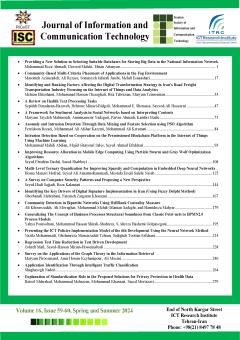تشخیص نفوذ مبتنی بر همکاری در بستر زنجیرهیبلوکی دارای مجوز در اینترنتاشیاء به روش یادگیری ماشین
الموضوعات : فناوری اطلاعات و ارتباطاتمحمد مهدی عبدیان 1 , مجید غیوری ثالث 2 , سید احمد افتخاری 3
1 - کارشناسی ارشد رایانش امن، گروه کامپیوتر دانشگاه جامع امام حسین (ع)
2 - گروه کامپیوتر دانشگاه جامع امام حسین (ع)،
3 - کارشناسی مهندسی کامپیوتر نرمافزار، دانشگاه آزاد اسلامی واحد تهران مرکز، تهران، ایران
الکلمات المفتاحية: تشخیص نفوذ, زنجیرهبلوکی, اینترنتاشیاء, یادگیری ماشین, تشخیص نفوذ مبتنی بر یادگیری ماشین,
ملخص المقالة :
در سیستمهای تشخیص نفوذ، افزایش نرخ تشخیصهای درست و کاهش زمان آموزش و تشخیص، کاهش بار پردازشی، نگهداشت مناسب مدل تشخیصدهنده و لاگهای حاصل، به طوری که توسط افراد غیرمجاز قابل دستکاری یا پاک شدن نباشند حائز اهمیت میباشد. بنابراین در این پژوهش، با بهرهمندی از مزایای زنجیرهبلوکی و قابلیت ماندگاری آن و با بهرهمندی از معماری IDS مبتنی بر همکاری چند گره به دنبال رفع مشکلات مطرح شده میباشیم. مدل بر اساس الگوریتم درخت تصمیم است که در گرههای معماری به عنوان موتور تشخیص نفوذ فعالیت میکند. معماری متشکل از چندین گره مرتبط در بستر زنجیرهبلوکی میباشد، مدل و لاگهای ایجاد شده در بستر زنجیرهبلوکی ذخیره شده و لذا به راحتی قابل دستکاری یا پاک شدن نیستند. کنار مزایای حاصل از به کارگیری زنجیرهبلوکی، مسالهی میزان حافظه اشغالی و سرعت و زمان انجام تراکنشها توسط زنجیرهبلوکی نیز مطرح میباشند. در این پژوهش مدلهای ارزیابی برای معماری تک گره و چند گره در بستر زنجیرهبلوکی، مطرح شده است. در نهایت اثبات معماری و تهدیدات احتمالی نسبت به معماری و راههای دفاع تشریح میشود. مهمترین مزایای طرح شامل حذف نقطهی شکست واحد، حفظ اعتماد بین گرهها و اطمینان از جامعیت مدل و لاگهای کشف شده میباشد.
[1] S. Smys, A. Basar, and H. Wang, "Hybrid intrusion detection system for internet of Things (IoT) ", Journal of ISMAC, vol. 2, no. 04, pp. 190-199, 2020.
[2] Y. N. Soe, Y. Feng, P. I. Santosa, R. Hartanto, and K. Sakurai, "Implementing Lightweight IoT-IDS on Raspberry Pi Using Correlation-Based Feature Selection and Its Performance Evaluation", Springer International Conference on Advanced Information Networking and Application, AINA: Advanced Information Networking and Applications, Vol. 926, pp. 458-469, 2019.
[3] O. Alkadi, N. Moustafa, B. Turnbull, and K. R. Choo, "Deep Blockchain Framework-enabled Collaborative Intrusion Detection for Protecting IoT and Cloud Networks", IEEE Internet of Things Journal, pp. 1-12, 2020.
[4] G. D. Putra, V. Dedeoglu, S. S. Kanhere, and R. Jurdak, "Poster Abstract: Towards Scalable and Trustworthy Decentralized Collaborative Intrusion Detection System for IoT," 2020 IEEE/ACM Fifth International Conference on Internet-of-Things Design and Implementation (IoTDI), pp. 256-257, 2020.
[5] W. Meng, E. W. Tischhauser, Q. Wang, Y. Wang, and J. Han, "When Intrusion Detection Meets Blockchain Technology: A Review," IEEE Access, vol. 6, pp. 10179-10188, 2018.
[6] S. Yakut, Ö. Şeker, E. Batur, and G. Dalkılıç, "Blockchain Platform for Internet of Things," 2019 Innovations in Intelligent Systems and Applications Conference (ASYU), Izmir, Turkey, pp. 1-6, 2019.
[7] H. T. T. Truong, M. Almeida, G. Karame, and C. Soriente, "Towards Secure and Decentralized Sharing of IoT Data", 2019 IEEE International Conference on Blockchain (Blockchain), Atlanta, GA, USA, pp. 176-183, 2019.
[8] A. Sforzin, F. G. Mármol, M. Conti, and J. -M. Bohli (2016), "RPiDS: Raspberry Pi IDS — A Fruitful Intrusion Detection System for IoT," 2016 Intl IEEE Conferences on Ubiquitous Intelligence & Computing, Advanced and Trusted Computing, Scalable Computing and Communications, Cloud and Big Data Computing, Internet of People, and Smart World Congress (UIC/ATC/ScalCom/CBDCom/IoP/SmartWorld), pp. 2016, 2016.
[9] A. M. Chandrasekhar, and K. Raghuveer, "Intrusion detection technique by using k-means, fuzzy neural network and SVM classifiers", 2013 International Conference on Computer Communication and Informatics IEEE, pp. 1-7, 2013.
[10] S. Iqbal, M. L. M. Kiah, B. Dhaghighi, M. Hussain, S. Khan, M. K. Khan, and K. K. R. Choo, "On cloud security attacks: A taxonomy and intrusion detection and prevention as a service.," Journal of Network and Computer Applications, pp. 98-120, 2016.
[11] P. Mehetrey, B. Shahriari, and M. Moh, "Collaborative ensemble-learning based intrusion detection systems for clouds.," 2016 International Conference on Collaboration Technologies and Systems (CTS), pp. 404-411, 2016.
[12] I. Andrea, C. Chrysostomou, and G. Hadjichristofi, "Internet of Things: Security vulnerabilities and challenges," IEEE Symposium on Computers and Communication (ISCC), Larnaca, pp. 180-187, 2015.
[13] R. Mahmoud, T. Yousuf, F. Aloul, and I. Zualkernan, "Internet of things (IoT) security: Current status, challenges and prospective measures," 10th International Conference for Internet Technology and Secured Transactions (ICITST) IEEE, London, pp. 336-341, 2015.
[14] S. Vashi, J. Ram, J. Modi, S. Verma, and C. Prakash, "Internet of Things (IoT): A vision, architectural elements, and security issues," International Conference on I-SMAC (IoT in Social, Mobile, Analytics and Cloud) (I-SMAC), Palladam, pp. 492-496, 2017.
[15] S. Nakamoto, "Bitcoin: A peer-to-peer electronic cash system,"2009. http://bitcoin.org/bitcoin.pdf.
[16] M., Crosby, N. P. Pattanayak, S. Verma, and V. Kalyanaraman, "BlockChain Technology: Beyond Bitcoin,," Applied Innovation Review, 2016.
[17] S. Zamani, Z. Moezkarimi, and Z. Golmirzaei (2019), "Classifying, Comparing, and Analyzing Blockchain Platforms," International Conference on Web Research, Tehran, Iran.
[18] T. W. Shinder, "The Best Damn Firewall Book Period," Elsevier, 2011.
[19] "research.unsw.edu.au," [Online]. Available: https://research.unsw.edu.au/projects/unsw-nb15-dataset.
[20] K. Yogesh, M. Karthik, T. Naveen, and S. Saravanan, "Design and Evaluation of Scalable Intrusion Detection System Using Machine Learning and Apache Spark," 2019 5th International Conference On Computing, Communication, Control And Automation (ICCUBEA), pp. 1-7, 2019.
[21] "https://hyperledger-fabric.readthedocs.io/en/release-2.2/peers/peers.html," 2020. [Online]. Available: https://hyperledger-fabric.readthedocs.io/en/release-2.2/peers/peers.html
[22] "hyperledger-fabric," 2020. [Online]. Available: https://hyperledger-fabric.readthedocs.io/en/release-2.2/membership/membership.html.
[23] "hyperledger-fabric," hyperledger-fabric, 2018. [Online]. Available: https://hyperledger-fabric.readthedocs.io/en/release-1.3/ledger/ledger.html.
[24] "pycryptodome," [Online]. Available: https://pycryptodome.readthedocs.io/en/latest/src/hash/sha3_256.html.
[25] "https://hyperledger-fabric.readthedocs.io," 2020. [Online]. Available: https://hyperledger-fabric.readthedocs.io/en/release-2.2/deployment_guide_overview.html.
[26] C. A. Ronao, and S. B. Cho, “Mining SQL queries to detect anomalous database access using random forest and PCA”, In International conference on industrial, engineering and other applications of applied intelligent systems (pp. 151-160). Springer, Cham., 2015.
[27] "https://hyperledger-fabric.readthedocs.io/en/release-2.2," 2020. [Online]. Available: https://hyperledger-fabric.readthedocs.io/en/release-2.2/create_channel/create_channel_config.html?highlight=batchtimeout#orderer


